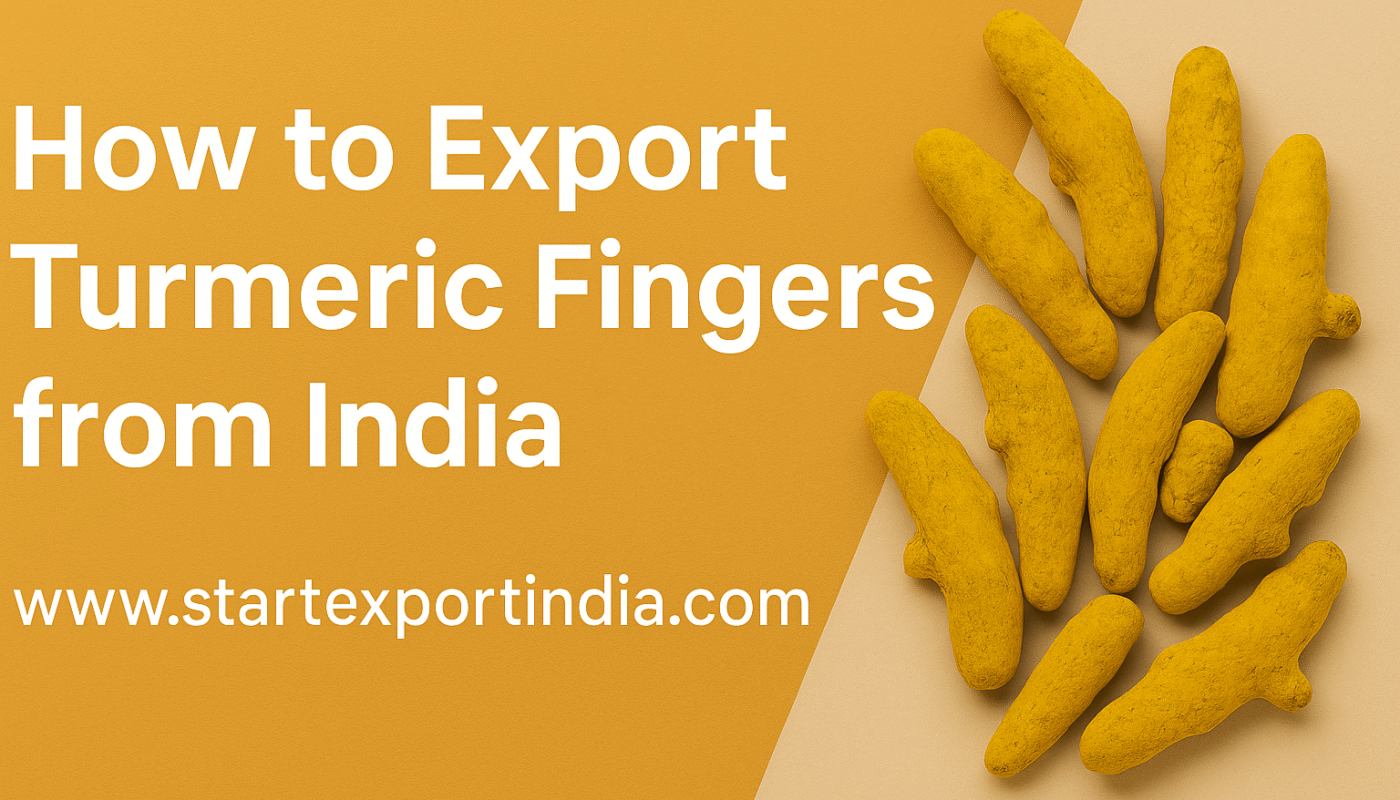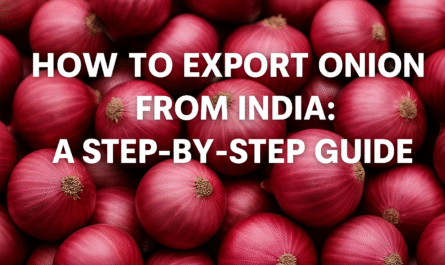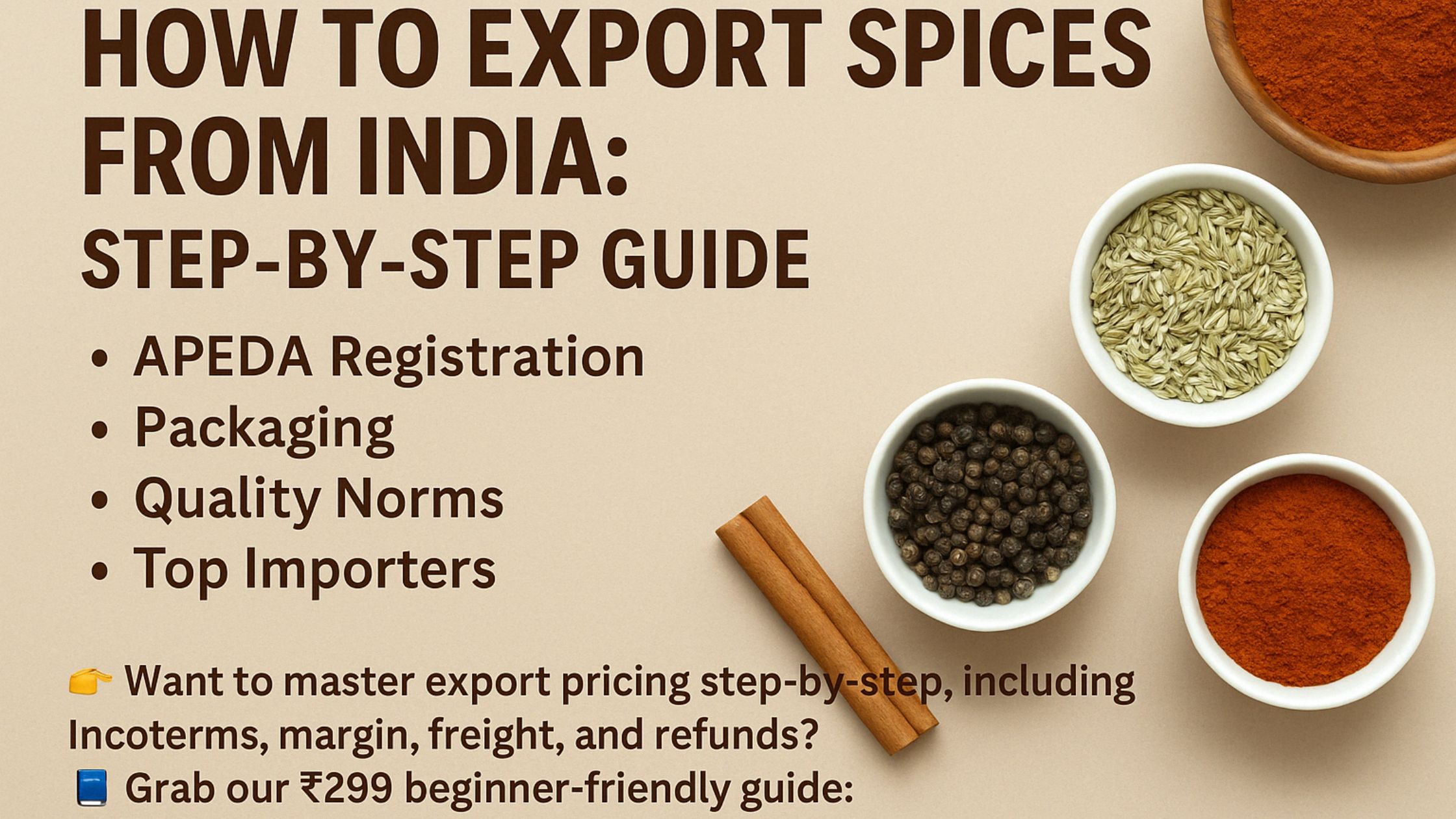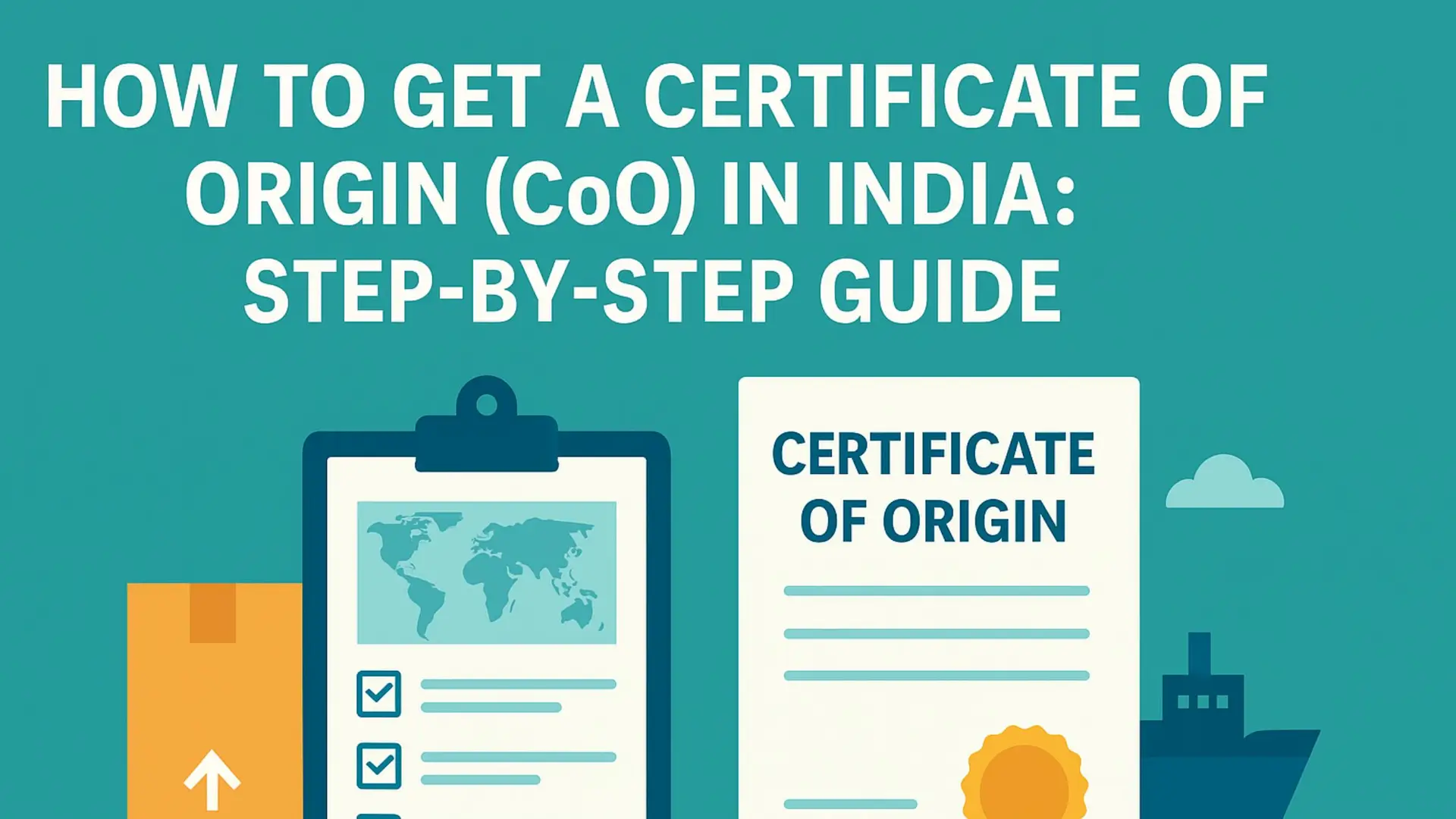- Introduction to Turmeric Fingers Export Business
- Why Export Turmeric Fingers from India?
- Understanding Turmeric Fingers and Global Market Trends
- Step 1: Registering Your Turmeric Export Business in India
- Step 2: Meeting Quality Standards and Certifications
- Step 3: Sourcing and Processing Turmeric Fingers
- Step 4: Finding Buyers for Turmeric Fingers
- Step 5: Documentation Required for Turmeric Exports
- Step 6: Choosing the Right Shipping Method
- Step 7: Pricing and Payment Terms
- Government Incentives and Support for Turmeric Exporters
- Common Challenges in Exporting Turmeric Fingers
- Pro Tips for Successful Turmeric Export Business
- FAQs About Exporting Turmeric Fingers from India
- Conclusion
Introduction to Turmeric Fingers Export Business
Turmeric, often called the “golden spice,” has been a staple of Indian kitchens and Ayurvedic medicine for centuries. Among its many forms, turmeric fingers — the dried and raw form of turmeric roots — hold the highest demand in global markets. If you’re an aspiring exporter, learning how to export turmeric fingers from India can open doors to a highly profitable business opportunity.
India already contributes more than 80% of the world’s turmeric production, making it the most trusted supplier for countries like the USA, UAE, Japan, Bangladesh, Iran, and many more. With rising awareness of turmeric’s health benefits, global demand continues to grow every year, making it the perfect time for Indian exporters to step into this business.
Why Export Turmeric Fingers from India?
India’s dominance in global turmeric production
India is the world’s largest producer and exporter of turmeric, contributing to nearly 1.5 million tonnes annually. States like Andhra Pradesh, Telangana, Tamil Nadu, Maharashtra, and Odisha are known for producing high-quality turmeric fingers.
Increasing international demand for turmeric fingers
The global shift towards organic and herbal products has skyrocketed turmeric consumption. From dietary supplements to beauty products, turmeric fingers are processed into powders, capsules, and extracts worldwide.
Profit potential for Indian exporters
Since turmeric fingers are in raw form, they fetch higher margins compared to processed turmeric powder. Exporters can also earn premium prices by offering organic and certified turmeric fingers to global buyers.
Understanding Turmeric Fingers and Global Market Trends
What are turmeric fingers?
Turmeric fingers are the dried rhizomes of the turmeric plant, harvested, boiled, and sun-dried before export. These are further polished and graded according to size, color, and curcumin content.
Key importing countries of turmeric fingers
Some of the top buyers of Indian turmeric fingers include:
- United States
- United Arab Emirates
- Japan
- Iran
- United Kingdom
- Bangladesh
Current market price trends and demand forecast
Global demand for turmeric fingers is expected to grow at 6-7% CAGR till 2030, driven by increasing health-conscious consumers. Prices vary depending on quality, ranging from $1,200 – $2,000 per metric ton in international markets.
Step 1: Registering Your Turmeric Export Business in India
Obtaining a business entity
Before starting exports, you need a legal business setup such as sole proprietorship, LLP, or Private Limited Company. This ensures credibility with foreign buyers.
Registering with DGFT and getting IEC
The Import Export Code (IEC) issued by the Directorate General of Foreign Trade (DGFT) is mandatory for turmeric exports.
GST registration
A valid GST number is required for filing taxes and availing export benefits.
Step 2: Meeting Quality Standards and Certifications
FSSAI license and food safety compliance
Since turmeric fingers fall under food commodities, an FSSAI license is compulsory to meet food safety norms.
APEDA registration for agricultural exports
The Agricultural and Processed Food Products Export Development Authority (APEDA) registration is mandatory for all agricultural exports, including turmeric fingers.
International certifications
Certifications like ISO, HACCP, and Organic Certification help exporters win premium buyers in the USA, EU, and Middle Eastern markets.
Step 3: Sourcing and Processing Turmeric Fingers
Identifying top turmeric-growing states
The best turmeric fingers come from Telangana (Sangli variety), Tamil Nadu, and Maharashtra, known for high curcumin content.
Post-harvest processing and grading
Turmeric fingers are boiled, dried, polished, and sorted based on size and color. Grading standards ensure consistency and buyer satisfaction.
Packaging requirements for international shipments
Turmeric fingers must be packed in jute or PP bags (25–50 kg each) with proper labeling, moisture protection, and fumigation certificates.
Step 4: Finding Buyers for Turmeric Fingers
Using B2B portals like Alibaba, IndiaMART, TradeIndia
Digital platforms are a goldmine for exporters. Creating verified profiles on Alibaba, TradeIndia, IndiaMART, and Global Sources allows you to connect with thousands of international buyers searching specifically for turmeric fingers.
Participating in international trade fairs
Events like Gulfood (Dubai), Anuga (Germany), and Foodex Japan attract global food buyers. Setting up a stall at these expos can help you build direct connections with distributors and retailers.
Partnering with export agents and wholesalers
If you’re new to exporting, working with export agents and wholesale traders can simplify the process. They help you find buyers, negotiate deals, and handle logistics in exchange for a commission.
Step 5: Documentation Required for Turmeric Exports
Exporting turmeric fingers requires proper documentation to comply with both Indian and international regulations. Missing paperwork can delay shipments and cause financial loss.
Commercial invoice and packing list
A commercial invoice outlines product details, HS codes, and total value, while a packing list specifies the number of bags and net weight.
Certificate of origin and phytosanitary certificate
A Certificate of Origin (CoO) is issued by export chambers to certify the product’s Indian origin. The phytosanitary certificate confirms that the turmeric fingers are pest-free and safe for import.
Bill of lading, airway bill, and insurance documents
These transport documents are required for customs clearance. Export insurance protects you against damages and shipment losses.
Step 6: Choosing the Right Shipping Method
Sea freight vs air freight for turmeric fingers
- Sea Freight: Cost-effective for bulk shipments (25–50 metric tons). Takes longer but is ideal for large exports.
- Air Freight: Faster delivery but more expensive, suitable for urgent or small consignments.
Customs clearance process in India
Exporters must submit shipping bills through the ICEGATE portal for customs clearance. Customs authorities verify documentation and inspect shipments before approving export.
Logistics partners and freight forwarding companies
Partnering with reputed freight forwarders like Maersk, DHL, or FedEx Trade Networks ensures smooth handling, customs support, and on-time delivery.
Step 7: Pricing and Payment Terms
Setting competitive prices in the export market
Pricing depends on curcumin content, finger length, and moisture level. Always research international price trends before finalizing deals.
Payment methods: LC, TT, advance payment
- Letter of Credit (LC) – safest method for exporters.
- Telegraphic Transfer (TT) – common for repeat buyers.
- Advance Payment – recommended for small trial orders.
Managing risks in international transactions
To reduce risks:
- Use export credit insurance (ECGC India).
- Work with reputed buyers.
- Sign legally binding export contracts.
Government Incentives and Support for Turmeric Exporters
Export promotion schemes (MEIS, RoDTEP)
The RoDTEP scheme (Remission of Duties and Taxes on Exported Products) refunds certain taxes to make Indian exports more competitive.
Subsidies for organic certification
The Indian government provides subsidies for farmers and exporters seeking organic certification under NPOP and NOP standards.
Role of Spices Board of India
The Spices Board of India plays a vital role in promoting exports, setting quality standards, and helping exporters with marketing assistance.
Common Challenges in Exporting Turmeric Fingers
Meeting buyer specifications and quality checks
International buyers demand strict quality consistency. Failure in lab tests (curcumin %, lead contamination, moisture) can lead to rejected consignments.
Competition from other turmeric exporting countries
Countries like Myanmar, Indonesia, and Vietnam are also entering the turmeric export market, creating price competition.
Handling logistics and timely delivery
Shipping delays, port congestion, or poor packaging can affect your reputation. Reliable logistics planning is key.
Pro Tips for Successful Turmeric Export Business
Building strong relationships with buyers
Maintaining long-term relationships with buyers ensures repeat orders. Communicate transparently and provide samples before bulk shipments.
Maintaining consistent quality and supply
Invest in sorting, polishing, and storage facilities to maintain a consistent supply throughout the year.
Using digital marketing for brand building
Build your own export website (like www.startexportindia.com) and use LinkedIn, Instagram, and YouTube to showcase your turmeric brand.
FAQs About Exporting Turmeric Fingers from India
Q1. Do I need a license to export turmeric fingers from India?
Yes, you need an IEC (Import Export Code), FSSAI license, and APEDA registration to export turmeric legally.
Q2. Which countries import the most turmeric fingers from India?
Top importers include the USA, UAE, Japan, UK, Iran, and Bangladesh.
Q3. How do I find international buyers for turmeric fingers?
You can use B2B platforms, trade fairs, social media marketing, and export agents to find reliable buyers.
Q4. What is the minimum investment required to start turmeric exports?
You can start with ₹5–10 lakhs for small-scale exports, covering registration, sourcing, packaging, and shipping.
Q5. What documents are mandatory for turmeric export?
Key documents include IEC, APEDA registration, FSSAI license, commercial invoice, packing list, bill of lading, phytosanitary certificate, and insurance documents.
Q6. How much profit can I make by exporting turmeric fingers?
Profit margins range from 15% to 25%, depending on sourcing price, quality, and international demand.
Conclusion
Exporting turmeric fingers from India is a lucrative business with huge potential in global markets. With India’s strong agricultural base and rising demand for natural health products, exporters can build sustainable businesses by following the right steps — registration, certification, sourcing, buyer acquisition, documentation, and logistics.
At Start Export India, we believe that with the right guidance, any entrepreneur can become a successful exporter. By maintaining quality, trust, and professionalism, you can establish long-term relationships with global buyers and make India’s golden spice reach every corner of the world.



